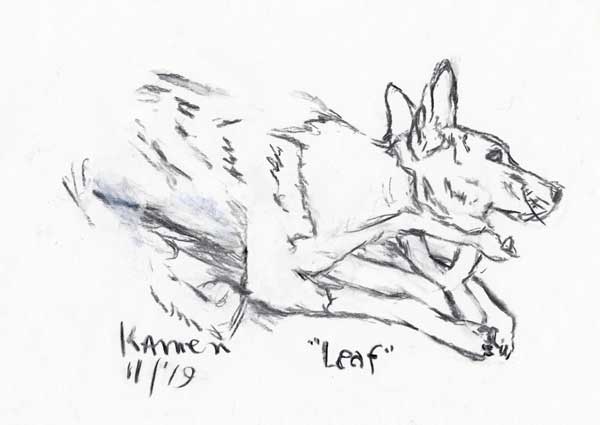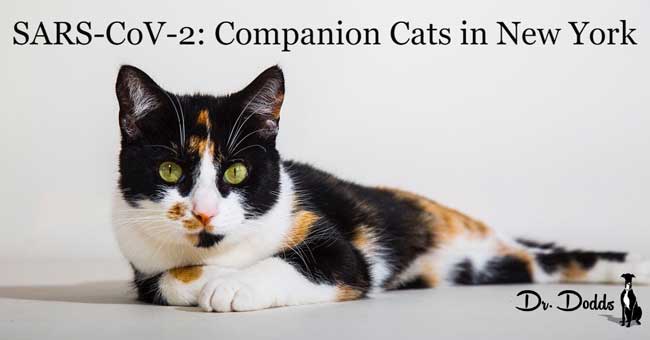Page 12 <previous page > <next page>
SOME HEALTH & SCIENCE NEWS
SARS-COV-2: COMPANION CATS IN NEW YORK
by W. Jean Dodds, DVM on April 27, 2020

In this latest update about SARS-CoV-2, the virus that causes COVID-19, we will begin with a direct statement from the American Veterinary Medical Association (AVMA), the press release by the U.S. Department of Agriculture (USDA) about the confirmatory SARS-CoV-2 cases of two companion cats in New York, followed by Dr. Dodds’ and Hemopet’s comments, and finish with the latest guidelines.
AVMA
American Veterinary Medical Association stated on April 23, 2020:
“It is important to note that there is little to no evidence that domestic animals are easily infected with SARS-CoV-2 under natural conditions and no evidence that they can transmit the virus to people. The primary mode of transmission of COVID-19 virus in humans is person-to-person via respiratory droplets and contact.”
PRESS RELEASE FROM USDA
Washington, D.C. April 22, 2020 – The U.S. Centers for Disease Control and Prevention (CDC) and the United States Department of Agriculture’s (USDA) National Veterinary Services Laboratories (NVSL) today announced the first confirmed cases of SARS-CoV-2 (the virus that causes COVID-19) infection in two pet cats. These are the first pets in the United States to test positive for SARS-CoV-2.
The cats live in two separate areas of New York state. Both had mild respiratory illness and are expected to make a full recovery. SARS-CoV-2 infections have been reported in very few animals worldwide, mostly in those that had close contact with a person with COVID-19.
At this time, routine testing of animals is not recommended. Should other animals be confirmed positive for SARS-CoV-2 in the United States, USDA will post the findings at https://www.aphis.usda.gov/aphis/ourfocus/animalhealth/SA_One_Health/sars-cov-2-animals-us.
State animal health and public health officials will take the lead in making determinations about whether animals should be tested for SARS-CoV-2.
In the NY cases announced today, a veterinarian tested the first cat after it showed mild respiratory signs. No individuals in the household were confirmed to be ill with COVID-19. The virus may have been transmitted to this cat by mildly ill or asymptomatic household members or through contact with an infected person outside its home.
Samples from the second cat were taken after it showed signs of respiratory illness. The owner of the cat tested positive for COVID-19 prior to the cat showing signs. Another cat in the household has shown no signs of illness.
Both cats tested presumptive positive for SARS-CoV-2 at a private veterinary laboratory, which then reported the results to state and federal officials. The confirmatory testing was conducted at NVSL and included collection of additional samples. NVSL serves as an international reference laboratory and provides expertise and guidance on diagnostic techniques, as well as confirmatory testing for foreign and emerging animal diseases. Such testing is required for certain animal diseases in the U.S. in order to comply with national and international reporting procedures. The World Organisation for Animal Health (OIE) considers SARS-CoV-2 an emerging disease, and therefore USDA must report confirmed U.S. animal infections to the OIE.
Public health officials are still learning about SARS-CoV-2, but there is no evidence that pets play a role in spreading the virus in the United States. Therefore, there is no justification in taking measures against companion animals that may compromise their welfare. Further studies are needed to understand if and how different animals, including pets, could be affected.
COMMENTS
It is really not surprising that we have a few positive cases of companion cats infected with SARS-CoV-2 from humans in natural settings. The companion pets tested to date have had mild symptoms. From a practical standpoint, we live in such close proximity – even more so these days – to our companion pets and breathe the same air that it just makes logical sense.
Two commercial laboratories in the United States have tested thousands of specimens from dogs and cats for SARS-CoV-2 live virus and did not obtain any positive results. These samples have come from the United States, South Korea, Canada, and Europe, including regions concurrently experiencing human COVID-19 cases. It is unknown if any of these animals had contact with confirmed SARS-CoV-2 positive people.
Always remember: infected is not the same as infectious. We have no evidence of pets infecting pets under natural conditions or of pets passing SARS-CoV-2 back to humans.
Also remember, SARS-CoV-2 is not the first virus humans can pass to their companion pets. We also have a handful or so of cases of companion pets catching human influenza and SARS-CoV-1 in the early 2000’s, as well as companion dogs infected with the mumps virus. All of these cases are due to human interaction. There is no evidence of pets passing these viruses around their species or passing them back to humans. The onus is on us.
We have been reluctant to report on the numerous SARS-CoV-2 studies involving companion pets that have been conducted and that are currently underway. They are important, but nonetheless small studies being rushed to publication can be misleading. An example is the early reported promising results in a few COVID-19 patients with remdesivir; subsequent larger studies have shown it to be ineffective and even harmful in some patients.
With all that being said, we comment here about the peer-reviewed paper “Susceptibility of ferrets, cats, dogs, and other domesticated animals to SARS–coronavirus 2”. We will directly quote the AVMA’s insightful interpretation.
“We emphasize caution in not overinterpreting the results described in these and other articles, and also caution about extrapolating them to the potential for SARS-CoV-2 to naturally infect or be transmitted by companion animals kept as pets. Our rationale is as follows:
Experimentally induced infection does not mirror naturally induced infection. Just because an animal can be experimentally infected via direct intranasal or intratracheal inoculation of high concentrations of purified tissue-cultured virus does not mean that it will be easily be infected with that same virus under natural conditions.
The numbers of animals used in these experiments were small and the conclusions drawn are based on data points that were in some cases collected from as few as two animals.
Transmission studies described in the recent Science article were conducted by placing one experimentally infected cat in a negatively pressurized isolator cage with a double-layer net divider separating it from its uninfected counterpart. In each isolator, HEPA-filtered air flow was directed from the inoculated to the naïve cat with a HEPA-filtered airflow outlet preventing recirculation of infectious virus particles. Only two of six uninfected cats in the 2020 study became infected via transmission of SARS-CoV-2 from experimentally infected cats. Results from so few animals in ideal conditions for viral transmission should not be used as conclusive evidence that infected cats can readily transmit COVID-19, particularly under natural conditions.”
Again, infected is not the same as infectious. We have no evidence of pets infecting pets under natural conditions or of pets passing SARS-CoV-2 back to humans.
Now, some people have become understandably frustrated with our position and pointed out, “The absence of evidence is not evidence of absence.”
We agree. We need to continue to find evidence. We need the evidence to be correct and validated. However, we cannot rush to judgment that may lead to irrational and unnecessary actions.
Additionally, we have to look at the preponderance of evidence from other viruses. Many viruses act the same way. Immunity is a good example. While we do not know how long or if people will develop immunity to SARS-CoV-2, we do know that we have a duration of immunity to many viruses if exposed. Therefore, it is fairly safe to assume we will have immunity to SARS-CoV-2. Particularly, we do have preliminary evidence of immunity.
A study successfully infected four rhesus monkeys with SARS-CoV-2. They knew this by measuring weight loss, viral replication and pneumonia. Once the symptoms cleared up, the monkeys were tested again using rRT-PCR test that looks for active SARS-CoV-2 virus. The monkeys had negative results. 29 days post-infection, two of monkeys were re-challenged with the same dose of the SARS-CoV-2 strain. After five days, the team measured viral loads in 96 nasopharyngeal and anal swabs. All tested negative.
Another example is a groundbreaking study released in 2008 about the 1918 pandemic. Researchers gathered 32 survivors who were born before 1915. 94% of them (30 people) had produced antibodies that neutralized the 1918 flu virus. The scientists went further and found out that the gene sequence that encoded these antibodies had accumulated many mutations, which suggests that the cells had made further adaptations to similar viruses after 1918. This means they would more than likely not become ill if the 1918 virus cropped up again.
Most importantly, we cannot repeat the mistakes of the past. During the SARS-CoV-1 in the early 2000’s, Chinese cities and provinces overreacted with only anecdotal evidence that led to thousands of civet cats as well as many companion dogs and cats being euthanized.
GUIDELINES
We all love our companion pets. They provide us so much more though. They give us mental well-being, routine, regularity, stability, comfort, and most importantly unconditional love. At this point in time, there is no reason whatsoever to abandon or relinquish our companion pets.
With that being said, the situation surrounding the SARS-CoV-2 virus is rapidly evolving. So, we need to proceed with an abundance of caution. We suggest following the AVMA guidelines, which are:
Animal owners without symptoms of COVID-19 should continue to practice good hygiene during interactions with animals. This includes washing hands before and after such interactions and when handling animal food, waste, or supplies.
Do not let pets interact with people or other animals outside the household.
Keep cats indoors, when possible, to prevent them from interacting with other animals or people.
Walk dogs on a leash, maintaining at least 6 feet from other people and animals. Avoid dog parks or public places where a large number of people and dogs gather.
Until more is known about the virus, those ill with COVID-19 should restrict contact with pets and other animals, just as you would restrict your contact with other people. Have another member of your household or business take care of feeding and otherwise caring for any animals, including pets. If you have a service animal or you must care for your animals, including pets, then wear a cloth face covering; don’t share food, kiss, or hug them, and wash your hands before and after any contact with them.
At this point in time, there is no evidence to suggest that domestic animals, including pets and livestock, that may be incidentally infected by humans play a role in the spread of COVID-19.
Routine testing of animals for SARS-CoV-2 is NOT recommended. Veterinarians are strongly encouraged to rule out other, more common causes of illness in animals before considering testing for SARS-CoV-2.
Human outbreaks are driven by person-to-person transmission. Accordingly, we see no reason to remove pets from homes even if COVID-19 has been identified in members of the household, unless there is risk that the pet itself is not able to be cared for appropriately.
